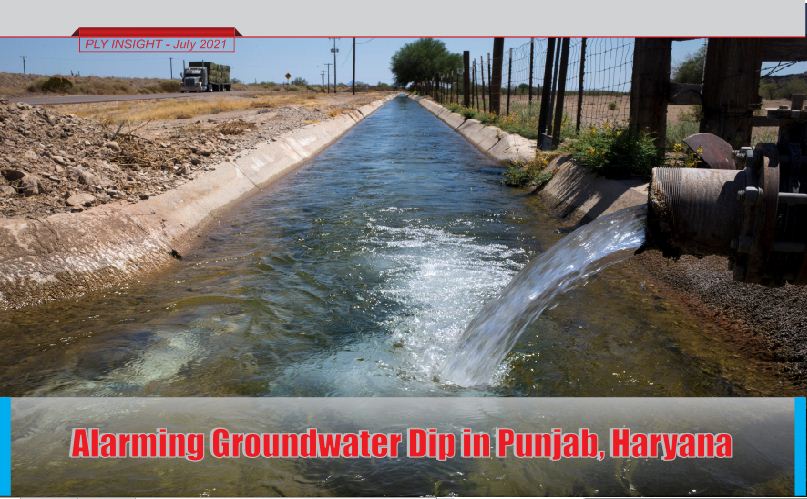
Alarming Groundwater Dip in Punjab, Haryana
- July 20, 2021
- 0
Groundwater level in North West India has dipped to alarming levels, especially in Punjab and Haryana, in the last four-five decades, according to a research paper published by IIT Kanpur.
India is the largest user of groundwater in the world for irrigation, domestic and industrial needs. The total annual ground water abstraction in India is about 245 km3, out of which about 90 percent is consumed for irrigation.
The states of Punjab and Haryana are the worst affected and the study led by Prof.Rajiv Sinha and his PhD student, Suneel Kumar Joshi, shows that shallow groundwater fell from 2 meters below ground level (bgl) during 1974, to about 30 metres bgl in 2010. This translate to an average loss of groundwater of more than 50 km3 (1.0 km3/year) particularly after 2002.
The study reveals that the rice cultivation area increased from 1.92 Lac to 14.22 Lac hectares between 1966-67 and 2017-18 for Haryana and from 2.27 Lac to 30.64 Lac hectares between 1960-61 and 2017-18 in Punjab. As a result, ground water abstraction increased to fulfill the demand.
Also, the most significant decline in groundwater level is recorded along the Ghaggar Hakra paleochannel (Kurukshetra, Patiala and Fatehabad districts), and in along the incised valley of the Yamuna River (parts of Panipat and Karnal districts).
The authors suggest that the rate of groundwater abstraction in Punjab and Haryana, which make up the leading agricultural region of India, rose sharply since the mid-20th century to support the “Green Revolution,” which was aimed at achieving self-sufficiency in food production.
The Green Revolution has been citied as the primary cause behind the dramatic all in groundwater levels in the region through uncontrolled pumping and groundwater abstraction by several studies earlier but this paper provided high resolution data on groundwater level change to validate the hypothesis.
Several areas in north-central Punjab and Haryana recorded a rapid fall in ground water levels that require immediate action in terms of enhanced monitoring of the change and intervention to mitigate against pressure from abstraction,” the study said.
In areas where agriculture is the most significant casual factor for the severe groundwater losses, reducing irrigation water demand must be a high priority, it added. In areas with thick and abundant aquifer bodies in the subsurface, managed aquifer recharge or groundwater banking is also feasible, the study said.
For areas where saline groundwater is present at shallow levels, artificial recharge schemes would be counter-productive, and would in any event suffer from low efficiency due to the limited amounts of aquifer material in the subsurface. Instead, rainwater harvesting combined with the development of channelized irrigation systems may be good option in such areas, it added.
पंजाब, हरियाणा में गहराया भूजल स्तर
आईआईटी कानपुर द्वारा प्रकाशित एक शोध पत्र के अनुसार, पिछले चार-पांच दशकों में, उत्तर पश्चिम भारत में भूजल स्तर खतरनाक स्तर तक गिर गया है, खासकर पंजाब और हरियाणा में।
भारत सिंचाई, घरेलू और औद्योगिक जरूरतों के लिए दुनिया में भूजल का सबसे बड़ा उपयोगकर्ता है। भारत में कुल वार्षिक भूजल निकासी लगभग 245 किमी 3 है, जिसमें से लगभग 90 प्रतिशत की खपत सिंचाई के लिए की जाती है।
पंजाब और हरियाणा राज्य सबसे बुरी तरह प्रभावित हैं और प्रोफेसर राजीव सिन्हा और उनके पीएचडी छात्र सुनील कुमार जोशी के नेतृत्व में किए गए अध्ययन से पता चलता है कि 1974 के दौरान उथला भूजल जमीनी स्तर (बीजीएल) से 2 मीटर नीचे गिरकर लगभग 30 मीटर बीजीएल हो गया।
2010 में यह विशेष रूप से 2002 के बाद 50 किमी 3 (1.0 किमी 3 ध् वर्ष) से अधिक के भूजल के औसत नुकसान को दर्शाता है।
अध्ययन से पता चलता है कि हरियाणा के लिए चावल की खेती का क्षेत्रफल 1.92 लाख से बढ़कर 14.22 लाख हेक्टेयर हो गया है और पंजाब में 1960-61 और 2017-18 के बीच यह 2.27 लाख से बढ़कर 30.64 लाख हेक्टेयर हो गया है। नतीजतन, मांग को पूरा करने के लिए भूजल का अवशोषण बढ़ गया।
इसके अलावा, भूजल स्तर में सबसे महत्वपूर्ण गिरावट घग्गर हाकरा पेलियोचैनल (कुरुक्षेत्र, पटियाला और फतेहाबाद जिले) और यमुना नदी (पानीपत और करनाल जिलों के कुछ हिस्सों) की कटी हुई घाटी में दर्ज की गई है।
लेखकों का सुझाव है कि पंजाब और हरियाणा, जो भारत के प्रमुख कृषि बने हुए हैं, में भूजल अवशोषण की दर 20 वीं शताब्दी के मध्य से ‘‘हरित क्रांति‘‘ का समर्थन करने के लिए तेजी से बढ़ी, जिसका उद्देश्य फसलों में आत्मनिर्भरता प्राप्त करना था।
हरित क्रांति को पहले कई अध्ययनों में अनियंत्रित पंपिंग और भूजल अवशोषण के माध्यम से क्षेत्र में भूजल स्तर में नाटकीय गिरावट के प्राथमिक कारण के रूप में बताया गया है, लेकिन इस शोघ पत्र ने सर्वमान्य तथ्यों के साथ भूजल स्तर परिवर्तन पर उच्च रिजॉल्यूशन डेटा प्रदान किया।
अध्ययन में कहा गया है कि उत्तर-मध्य पंजाब और हरियाणा के कई क्षेत्रों में भूजल स्तर में तेजी से गिरावट दर्ज की गई है, जिससे भूजल में बदलाव की निगरानी बढ़ाने और दबाव को कम करने के लिए तत्काल कार्रवाई की आवश्यकता है।
उन क्षेत्रों में जहां गंभीर भूजल नुकसान के लिए कृषि सबसे महत्वपूर्ण आकस्मिक कारक है, सिंचाई के पानी की मांग को कम करना एक उच्च प्राथमिकता होनी चाहिए। अध्ययन में कहा गया है कि उपसतह में मोटे और प्रचुर जलभृत निकायों वाले क्षेत्रों में, प्रबंधित जलभृत पुनर्भरण या भूजल बैंकिंग भी संभव है।
उन क्षेत्रों के लिए जहां खारा भूजल उथले स्तर पर मौजूद है, कृत्रिम पुनर्भरण योजनाएं प्रतिकूल होंगी, और किसी भी स्थिति में उपसतह में जलभृत सामग्री की सीमित मात्रा के कारण कम दक्षता से ग्रस्त होंगी। इसके बजाय, ऐसे क्षेत्रों में चैनलाइज्ड सिंचाई प्रणालियों के विकास के साथ वर्षा जल संचयन एक अच्छा विकल्प हो सकता है।
































































